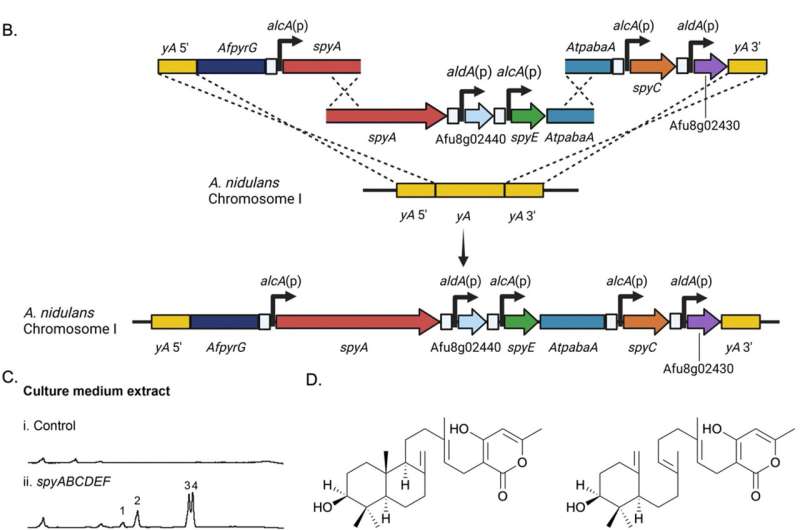This article has been reviewed according to Science X's editorial process and policies. Editors have highlighted the following attributes while ensuring the content's credibility:
fact-checked
peer-reviewed publication
trusted source
proofread
Researchers shed light on how one deadly pathogen makes its chemicals

Investigators at the University of Kansas have played a key role in deciphering a previously unidentified cluster of genes responsible for producing sartorypyrones, a chemical made by the fungal pathogen Aspergillus fumigatus, whose family causes Aspergillosis in humans.
Their findings recently were published inChemical Science.
Aspergillosis threatens the lives of more than 300,000 people each year. A better understanding of the genes responsible for the chemicals—or "secondary metabolites"—produced by A. fumigatus and its fungal cousins could help researchers develop more effective antifungal drugs.
"Fungal infections pose a significant challenge and have garnered increased attention in the media, including scientific reports," said corresponding author Berl Oakley, Irving S. Johnson Distinguished Professor of Molecular Biology at KU.
"Among the problematic organisms is a fungus known as Aspergillus fumigatus. The majority of individuals afflicted with severe pathogenic fungal infections fall into the category of immunocompromised, such as individuals undergoing cancer treatment or those living in sub-Saharan Africa, where a significant number of people that are affected by AIDS aren't getting medication."
Oakley and his co-authors were interested in how Aspergillus fumigatus produced secondary metabolites, which often are considered for their medicinal potential—even though they can be tough to study in the lab—because they're so biologically active.
"Studies have identified numerous gene clusters in fungi responsible for producing these metabolites," he said.
"But these compounds aren't typically produced under standard laboratory conditions, leaving many of their properties uncharted. These metabolites, while not essential for an organism's growth, offer selective advantages. They can protect against factors like UV radiation and inhibit competitive species. Some of these secondary metabolites exhibit bioactivities beneficial for various purposes. Others contribute to pathogenic effects, including immune system suppression."
To isolate and analyze the genes in Aspergillus fumigatus that express secondary metabolites, the team transferred a group of these genes—called a biosynthetic gene cluster (BGC)—to a related strain of Aspergillus, A. nidulans, then activated them. A. nidulans has been modified by researchers to be a model fungal species for this technique, dubbed "heterologous expression."
"We then can observe the compounds they produce in the lab," Oakley said. "In one instance, a gene cluster revealed the synthesis of sartorypyrones, a group of compounds with limited prior knowledge of their production."
The research team named the gene cluster responsible for these compounds the "spy BGC" (spy standing for sartorypyrones). They analyzed the compounds produced by the spy BGC using high-resolution electrospray ionization mass spectrometry, nuclear magnetic resonance, and microcrystal electron diffraction (MicroED) to identify 12 chemical products from the spy BGC.
Oakley led the work with longtime collaborator and corresponding author Clay C.C. Wang of the University of Southern California. At KU, Oakley carried out the investigation with C. Elizabeth Oakley and doctoral student Cory Jenkinson. Other co-authors were Shu-Yi Lin and Paul Seidler from USC; Yi-Ming Chiang from Taipei Medical University; Ching-Kuo Lee, Christopher Jones, and Hosea Nelson from the California Institute of Technology; and Richard Todd from Kansas State University
They report seven of the compounds had not been isolated previously.
"The spy BGC consists of six contiguous genes involved in the biosynthesis of the sartorypyrones," they report. "We were able to propose a biosynthetic pathway for this family of compounds. Our approach of refactoring the entire gene cluster in the dereplicated A. nidulans host system provides us with a straightforward way to dissect the biosynthetic pathway."
Oakley said the same technique could lead to more breakthroughs in understanding A. fumigatus and other fungal pathogens. The results could lead to new therapies for fungal infection as well as eco-friendly industrial uses. For instance, one of Oakley's other lines of research used genetically modified A. nidulans to convert ocean plastics into raw materials for the pharmaceutical industry.
He said the current paper reflects a proof-of-principle.
"We would like to express the remaining secondary metabolite gene clusters so we know what each one makes," he said. "We know what 15 or so of them make already. We know that it's a serious pathogen, and we know some of the secondary metabolites that contribute to pathogenesis. But we don't know all of the secondary metabolite gene clusters. If we figure them out, then researchers can use that information therapeutically to understand the mechanisms of infection and figure out ways to limit infection."
However, Oakley cautioned the economic realities of manufacturing antifungal medications could hamper the rapid development of new drugs.
"We need more antibiotics and more antifungals," he said. "But they're not profitable. A profitable compound is something that they can give to people for 30 years, not something you give for a week that solves the problem. So there's not much financial incentive. You can come up with the best antibiotic in the world; they're going to sit it on the shelf because it's going to be the last resort, and they're only going to use it when the other ones don't work."
More information: Shu-Yi Lin et al, A heterologous expression platform in Aspergillus nidulans for the elucidation of cryptic secondary metabolism biosynthetic gene clusters: discovery of the Aspergillus fumigatus sartorypyrone biosynthetic pathway, Chemical Science (2023). DOI: 10.1039/D3SC02226A
Journal information: Chemical Science
Provided by University of Kansas





















